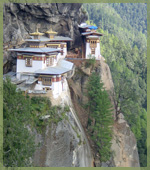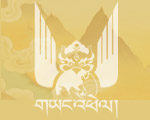 Clinging
to a black rock face, 800 meters above the valley floor, nestles
Taktsang Lhakhang, one of the holiest sites of Himalayan Buddhism.
Such is the sense of peace and serenity as the quiet approach
path winds through lush meadow, oak and rhododendron forest,
past quaint hamlets, fluttering prayer flags and rotating prayer
wheels, and along the precipitous cliff, it is difficult to
believe that Bhutan's only airport is barely kilometers away.
Taktsang, the tiger's lair, acquires its name from the legend
of its foundation, when in the 8th Century Guru Rinpoche, widely
revered as the second Buddha, arrived from Tibet flying across
the mountains on the back of a tigress. He meditated at the
site for three months, from where he used the religious cycle
of the Kagye to subjugate the Eight Categories of Evil Spirits,
and thus converted the region to Buddhism. Over the centuries
many luminaries came to meditate at this intensely spiritual
place, enriching the legacy of its founding master and strengthening
belief in the Buddhist faith. Clinging
to a black rock face, 800 meters above the valley floor, nestles
Taktsang Lhakhang, one of the holiest sites of Himalayan Buddhism.
Such is the sense of peace and serenity as the quiet approach
path winds through lush meadow, oak and rhododendron forest,
past quaint hamlets, fluttering prayer flags and rotating prayer
wheels, and along the precipitous cliff, it is difficult to
believe that Bhutan's only airport is barely kilometers away.
Taktsang, the tiger's lair, acquires its name from the legend
of its foundation, when in the 8th Century Guru Rinpoche, widely
revered as the second Buddha, arrived from Tibet flying across
the mountains on the back of a tigress. He meditated at the
site for three months, from where he used the religious cycle
of the Kagye to subjugate the Eight Categories of Evil Spirits,
and thus converted the region to Buddhism. Over the centuries
many luminaries came to meditate at this intensely spiritual
place, enriching the legacy of its founding master and strengthening
belief in the Buddhist faith.
Through its setting and history, Taktsang stands as a evocative
metaphor for Bhutan itself, alluding to some of the defining
elements of the diminutive Himalayan kingdom: a spiritual
sanctuary, enriched by the thoughts and actions of its ancestors
and an enduring intensity of faith; an ecological enclave,
where geographical circumstance and human humility have united
to preserve an abundant, multi-layered, undistracted environment;
a secluded land, occupying a precarious niche in a fast encroaching
modern world. Drukyul, the Land of the Thunder Dragon, is
particularly distinctive in that it has preserved its overall
identity to remain a traditional microcosm somewhat removed
from wider global realities. The nation has thus far been
blessed with the ability to reproduce itself through ever
changing circumstances. In 1998 the Taktsang complex was heavily
damaged by fire. The following year popular excitement greeted
the discovery of a young boy as the reincarnation of Tenzing
Rabgye, the fourth temporal ruler of Bhutan, responsible for
originally building the destroyed buildings in 1692. The successful
reconstruction is now nearing completion.
|



